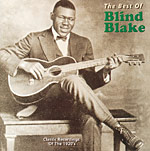 Of the two, Jefferson was the earlier and more conventional blues
artist. A powerful singer who wrote his own music and accompanied
himself on the guitar, Jefferson was the first
male blues superstar, and enjoyed a highly successful recording career
whose influence was still being felt 1961, when Bob Dylan recorded
"See That My Grave Is Kept Clean" on his debut album. Being the first
out of the gate may have accounted for some of Jefferson's success;
his
songs and their variations became part of the blues canon, but how much
of it was Jefferson and how much was part of the tradition he came from is
impossible to establish. What is clear is that in his time his skills
as a performer were renown, and he introduced a whole genre to a broader
audience. Along with Jefferson's unusual style of
self-accompaniment, the appeal to modern listeners is the chance to hear these songs in
their earliest form. But the intervening years have produced more evolved
styles of guitar playing, and despite the archivists' best efforts, the sound
quality of these recordings is marginal.
Of the two, Jefferson was the earlier and more conventional blues
artist. A powerful singer who wrote his own music and accompanied
himself on the guitar, Jefferson was the first
male blues superstar, and enjoyed a highly successful recording career
whose influence was still being felt 1961, when Bob Dylan recorded
"See That My Grave Is Kept Clean" on his debut album. Being the first
out of the gate may have accounted for some of Jefferson's success;
his
songs and their variations became part of the blues canon, but how much
of it was Jefferson and how much was part of the tradition he came from is
impossible to establish. What is clear is that in his time his skills
as a performer were renown, and he introduced a whole genre to a broader
audience. Along with Jefferson's unusual style of
self-accompaniment, the appeal to modern listeners is the chance to hear these songs in
their earliest form. But the intervening years have produced more evolved
styles of guitar playing, and despite the archivists' best efforts, the sound
quality of these recordings is marginal.
 Blind Blake, however, provides a much more substantial link to the direction
the guitar would take. Blake played in the more sophisticated ragtime style,
laying down syncopated
bass lines with his thumb while picking out complex melodic patterns with
his fingers, and anyone interested in the fingerpicking styles of
Ry Cooder (who recorded Blake's "Diddie Wa Diddie") and Jorma Kaukonen can
hear where it all started on these tracks.
The Blake collection also benefits from better fidelity,
perhaps a function of the guitarist's forceful playing style, which
projects with considerably greater impact than Jefferson's.
But both anthologies provide a fascinating insight into the origins of the
American guitar slinger and the vast blues tradition that evolved around him.
Blind Blake, however, provides a much more substantial link to the direction
the guitar would take. Blake played in the more sophisticated ragtime style,
laying down syncopated
bass lines with his thumb while picking out complex melodic patterns with
his fingers, and anyone interested in the fingerpicking styles of
Ry Cooder (who recorded Blake's "Diddie Wa Diddie") and Jorma Kaukonen can
hear where it all started on these tracks.
The Blake collection also benefits from better fidelity,
perhaps a function of the guitarist's forceful playing style, which
projects with considerably greater impact than Jefferson's.
But both anthologies provide a fascinating insight into the origins of the
American guitar slinger and the vast blues tradition that evolved around him.
